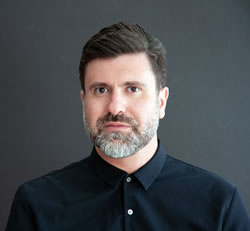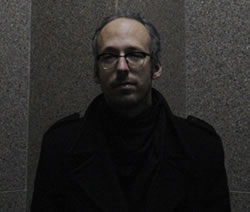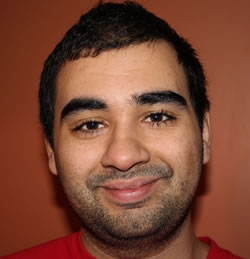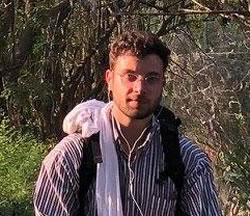[Jeu de temps / Times Play 2019]
Winning Works and Composers
Winners / Gagnants | Submissions / Soumissions | Events / Événements | Awards / Prix | Jury
For each edition of JTTP, a broad and diverse international jury has the task of judging all submissions to the project. The composers of the five top-placing works receive prize packages consisting of CDs, DVDs, books and magazine subscriptions, and the composers of the top three works additionally receive cash prizes. The many generous JTTP 2019 Project Partners, Financial Donors and Media Partners are listed on the Awards, Project Partners and Support page. Over the course of the 2019-20 year, the winning works (listed below) are presented in a number of Events, Concerts and Radio Broadcasts coordinated with our Media Partners. Check out the Participants and Submissions page to hear all works submitted to this year’s edition of JTTP, and to read programme notes and composer biographies.
1. Nicola Giannini — Eyes Draw Circles of Light (2019 / 9:18)

Eyes Draw Circles of Light explore des aspects spécifiques de l’inconscient lorsqu’on est sur le point de s’endormir. Au moyen de la spatialisation sonore, la relation entre la psyché et le corps est évoquée. L’accent est sur ces mouvements involontaires rapides, les secousses hypniques, qui marquent ce moment. La pièce est le fruit d’une collaboration avec les artistes Elisabetta Porcinai et Alice Nardi, qui ont écrit un poème pour la pièce, et vise à trouver un équilibre entre élégance et expérimentation, féminité et masculinité. Elisabetta a interprété le texte, que a été élaboré dans le cadre de la composition. L’œuvre a été composée pour un dôme de haut-parleurs.
Eyes Draw Circles of Light explores specific aspects of the human unconscious, characterizing that brief moment when we are about to fall sleep. Through sound spatialization, a multidimensional unconscious representation was created that evokes the relationship between psyche and body. The fast and involuntary body movements, hypnic jerks, that may occur at that time have been underlined. The work is a collaboration with the artists Elisabetta Porcinai and Alice Nardi, who wrote a poem for it, and aims to find a balance between elegance and experimentation, femininity and masculinity. The text was interpreted by Elisabetta and then elaborated by the composer. The work was composed for a dome of speakers.
Nicola Giannini est un artiste sonore et un compositeur de musique électroacoustique basé à Montréal. Sa pratique s’articule autour de la musique immersive, acousmatique ou en direct. Il s’intéresse aux sons qui évoquent des matériaux physiques et des organismes vivants. Ses œuvres ont été présentées au Toronto International Electroacoustic Symposium (TIES), Cube Fest, ICMC, Nycemf (É.-U.), TEDxLondon, Sound-Image Colloquium (R.-U.), Sound Spaces (Suède), File Festival (Brésil), Museo Palazzo Strozzi, Audior, Tempo Reale (Italie), parmi d’autres. Sa pièce Eyes Draw Circles of Light a reçu une mention d’honneur au Concours 2019 de la Fundación Destellos, tandis que For Hannah a été choisie comme finaliste au concours international de composition Città di Udine 2018. Originaire d’Italie, Nicola est titulaire d’une maîtrise en composition électroacoustique du Conservatoire de Florence. Il est étudiant au doctorat à l’Université de Montréal sous la direction de Robert Normandeau et il est actuellement assistant de recherche au Groupe de recherche en immersion spatiale.
Nicola Giannini is a sound artist and an electroacoustic music composer based in Montréal whose practice focuses on immersive music, both acousmatic and performed. He is interested in sounds that evoke physical materials and living organisms. His works have been presented at the Toronto International Electroacoustic Symposium (TIES), Cube Fest, ICMC, Nycemf (USA), TEDxLondon, Sound-Image Colloquium (UK), Sound Spaces (Sweden), File Festival (Brazil), Palazzo Strozzi Museum, Audior and Tempo Reale (Italy), among others. His piece Eyes Draw Circles of Light received an honourable mention at the Fundación Destellos 2019 Competition, while For Hannah was chosen as a finalist in the Città di Udine 2018 International Composition Competition. Originally from Italy, Nicola holds a master’s degree in Electroacoustic Composition from the Conservatory of Florence. He is a doctoral student at the Université de Montréal under the supervision of Robert Normandeau and is presently a research assistant with the Groupe de recherche en immersion spatiale (GRIS).
2. Roger Tellier-Craig — Nulle part à trouver (2019 / 17:39)

Contradictions. Différence. Intrusion d’un certain désordre dans une situation donnée, régularisée. Perte de repères. Nulle part à trouver cherche à organiser des tensions à travers l’utilisation d’écarts et de contrastes, créant ainsi un vaste réseau relationnel. L’objectif était d’élaborer un environnement sonore riche en possibilités, qui ne saurait être facilement réduit à chaque instant donné d’une écoute, où l’apparence d’une certaine direction, d’un sens quelconque, pourrait se voir annulée ou enrichie par l’introduction de sonorités ou de comportements contraires.
Contradictions. Difference. The intrusion of some kind of disorder in a stable, given situation. To be destabilized and lose your points of reference. Nulle part à trouver seeks to organize tensions through the use of differences and contrasts, creating an extensive network of relationships. The objective was to develop a sonic environment, rich in possibilities, which would not be easily reduced to any given moment in the piece, and where the appearance of any kind of direction or meaning would be either annihilated or enriched by the introduction of opposing behaviours or sounds.
Roger Tellier-Craig est un compositeur et musicien électronique basé à Montréal. Actif au sein de la scène musicale indépendante montréalaise depuis plus d’une quinzaine d’années, il est membre fondateur des groupes Fly Pan Am, Et Sans (aux côtés de Alexandre St-Onge), Set Fire to Flames, Le Révélateur (avec Sabrina Ratté) et Fousek / Hansen / Tellier-Craig. Son travail a été publié sur une panoplie de labels internationaux, dont Constellation, Locust, Alien 8, Fat Cat, Root Strata, Gneiss Things, NNA Tapes, Where To Now? et Dekorder, et présenté sur scène au Canada, en Europe, aux États- Unis et au Japon. Il a également composé de la musique pour le cinéma et la danse, travaillant avec Denis Côté, Albéric Aurtenèche, Projet EVA, Lynda Gaudreau, Dana Gingras et Sabrina Ratté. Il est titulaire d’un certificat en composition électroacoustique du Conservatoire de musique de Montréal.
Roger Tellier-Craig is an electronic musician and composer based out of Montréal. He shares an improvisation trio with Karl Fousek and Devon Hansen and is a founding member of Fly Pan Am, Et Sans (with Alexandre St-Onge), Set Fire to Flames, and Le Révélateur (with Sabrina Ratté). These projects have seen him tour extensively in Canada, Europe, the United States and Japan, as well as releasing records with Constellation, Locust, Alien 8, Fat Cat, Root Strata, Gneiss Things, NNA Tapes, Where To Now? and Dekorder. He has composed music for film and various art projects, working with Denis Côté, Albéric Aurtenèche, Projet EVA and Lynda Gaudreau, as well as providing the score to most of Sabrina Ratté’s video works. He has also worked closely with the choreographer Dana M. Gingras over the past 15 years. He holds a certificate in electroacoustic composition from the Conservatoire de Musique de Montréal.
3. Léa Boudreau — Quatre machines pour sauver le monde (2019 / 12:20)

En janvier 2019, de jeunes élèves de l’école Jean-Baptiste-Meilleur à Montréal ont participé à un petit remue-méninges: imaginer des machines fantastiques sous la thématique « Quatre machines pour sauver le monde ». Aucune limite, aucune autre consigne, toutes les idées étaient les bienvenues. C’est donc à partir de leurs suggestions que j’ai composé cette pièce, exprimant en son et en musique les engins pensés par les jeunes, mais également l’environnement les entourant. L’œuvre est divisée en quatre sections qui respectent les titres originaux donnés par les étudiant.e.s:
- Une machine volante qui fonctionne à la pollution et qui la transforme en air pur.
- Une machine-robot en forme d’animal pour sauver les animaux qui n’ont pas de maison et qui sont dans la rue.
- Une machine pour envoyer toute la neige qui tombe ici au pôle Nord pour ne plus que ça fonde.
- Une machine-bateau-sous-marin pour nettoyer les océans.
In January 2019, young students from Jean-Baptiste-Meilleur school in Montréal took part in a little brainstorm: to imagine fantastic machines under the theme “Quatre machines pour sauver le monde” (Four Machines to Save the World). No limit, no other instruction, all ideas were welcomed. Borrowing their suggestions, I composed this piece, expressing with sound and music the devices thought out by the youngsters but also their surrounding environment. The work is divided into four parts which respect the original titles given by the schoolchildren:
- A flying machine functioning with pollution and turning it into fresh air.
- An animal-shaped robot-machine to save homeless animals that live in the streets.
- A machine to send all the snow falling here to the North Pole so it doesn’t melt anymore.
- A machine-boat-submarine to clean the oceans.
Léa Boudreau est une compositrice et musicienne basée à Montréal. Elle entretient une relation passionnée avec le son dès l’adolescence où elle passe ses journées en ermite à écouter et à faire de la musique. Peu de choses ont vraiment changé. Elle dirige aujourd’hui sa création vers la composition et la performance où elle désire explorer les possibilités infinies et insoupçonnées des objets du quotidien et exprimer les 1000 idées qui lui passent par la tête à toute heure du jour et de la nuit. Elle remporte plusieurs prix au cours des dernières années : le 3e prix dans JTTP 2019 de la Communauté électroacoustique canadienne (CEC), la 3e place de la compétition SIME (Université de Lille), le prix Marcelle (Faculté de Musique de l’Université de Montréal) en 2019 et le 3e prix Hugh Le Caine (pour les jeunes compositeurs de la Fondation SOCAN) en 2017.
Léa Boudreau is a composer and musician based in Montréal. She has nourished a passionate relationship with sound since her teenage years, a time when she would spend days on end as a hermit, listening and creating… oh, how little things have changed! Nowadays, she continues to create in the realms of performance and composition, driven by a desire to explore the infinite sonic possibilities of everyday objects and to express the multitude of musical ideas keeping her awake at night. She has received several awards in recent years: the 3rd prize in JTTP 2019 from the Canadian Electroacoustic Community (CEC), the 3rd place in SIME competition (Lille University), the Marcelle Prize (Faculté de Musique de l’Université de Montréal) in 2019 and the 3rd Hugh Le Caine Prize (SOCAN Foundation Awards for Young Composers) in 2017.
4. Valentin Stip — 1109 (2018 / 8:06)

1109, pour cinq enceintes, s’essaie à l’expression d’un mal-être socio-politique qui s’est avéré trop complexe pour être exprimé à travers le langage. En tant que telle, la pièce s’est développée en un exercice de création et recherche sonore par le biais de la synthèse modulaire analogique. L’œuvre a été composée presque entièrement avec des sons créés sur le système Doepfer A-100 de l’Université Concordia, enregistrés sur une période de trois mois.
1109, a five-channel, fixed-media piece, attempts to sonically express socio-political thoughts and emotions that have personally proven too complex for language. As such, it was also an exercise in sound creation research using modular analogue synthesis. 1109 was composed almost exclusively with unprocessed sounds recorded with the Doepfer A-100 system at Concordia University over a three-month period.
Valentin Stip est français de naissance, mais grandit à New York. Pendant son BA en philosophie à Montréal, il découvre la musique électronique, avec laquelle il expérimentera pendant quelques années. Obsédé par le détail, il découvre petit à petit la beauté d’expérimenter avec les caractéristiques micro-temporelles du son. Ceci l’amène éventuellement à rejoindre le programme d’Électroacoustique de Concordia, qui l’aidera beaucoup à pousser cette approche, et où il complète actuellement sa dernière année d’étude. Valentin s’intéresse particulièrement à la composition, la perception et la relation que les deux procédés entretiennent, relation qu’il explore actuellement dans un effort d’allier ses acquis en métaphysique avec la recherche récente en psychoacoustique.
Born in France, Valentin Stip grew up in New York. While completing his BA in Philosophy in Montréal, he discovered electronic music and experimented with it for a few years. Through his fascination for the smallest of details he came to discover the beauty of experimenting with sound on an ever-shortening microscale. This led him to join Concordia University’s Electroacoustic Studies programme, which has greatly helped him exploit this approach, and where he is currently completing his final year of studies. Valentin is particularly interested in composition and perception, as well as the relationship forged between the two, a relationship he is currently exploring in an attempt to combine his background in metaphysics and recent research in psychoacoustics.
5. Diego Bermudez Chamberland — Buscando la luz (2018 / 10:09)

C’est à travers le processus de création de matériaux sonores et l’édition de cette composition que j’ai approfondi mon travail sur l’articulation des sons synthétiques. Cette approche est née du désir de donner vie aux sons synthétiques et de les faire coexister dans un univers sonore non référentiel. Buscando la luz est un voyage dans les coins les plus sombres de l’esprit: à la recherche de la lumière.
It is through the process of creating sound materials and the editing of this composition, that I deepened my work on the articulation of synthetic sounds. This approach is borne of a desire to give life to synthetic sounds and have them coexist in a non-referential sound universe. Buscando la luz is a journey into the darkest corners of the mind: in search of light.
Diego Bermudez Chamberland a débuté son parcours musical en jouant de la batterie pour ensuite plonger dans la musique électronique dès son adolescence. Nourri d’une fascination pour les rythmes et d’une curiosité envers les outils numériques, il développe sa pratique lors de multiples nuits blanches. Diplômé du baccalauréat en musiques numériques de l’Université de Montréal, il consacre son temps à la découverte de nouvelles sonorités à travers ses multiples projets musicaux et au développement de son entreprise de conception sonore Slope Audio. Sa pratique musicale est inspirée de ses expériences vécues autant sur le plan humain que dans la musique. Il est influencé par tous les genres musicaux qu’il a écoutés, les gens avec lesquels il a collaboré et par ses voyages à travers le monde. Diego a entamé une maîtrise en composition électroacoustique au Conservatoire de musique de Montréal en 2019.
Diego Bermudez Chamberland developed a passion for music while playing drums and immersing himself in electronic music as a teenager. Nourished by a fascination for rhythms and a curiosity for digital tools, he developed his practice over the course of many sleepless nights. A growing passion for sound design led him to explore sound creation for video games. A graduate of the Bachelor of Digital Music at the Université de Montréal, he spends much of his waking time discovering new sounds through his many musical projects and developing his sound design company, Slope Audio. His musical practice is inspired by both human-level and musical experiences. He is influenced by all the musical genres he has listened to, the people with whom he has collaborated and his travels around the world. Diego began a master’s degree in electroacoustic composition at the Conservatoire de musique de Montréal in 2019.
5. Benjamin Duplantie Grenier — Terre (2019 / 8:00)

Récit d’un paysage sonore absolu oscillant littéralement entre nature et humanité. Œuvre animée par des sons guides papillonnants qui tracent le chemin à travers la forêt dense pour finir inévitablement dans un éclat plastique, humain. La ligne conductrice vibre et oscille faisant trembler avec elle l’ensemble de la pièce et révèle ainsi son essence. Comment parler d’humanité sans parler de nature et comment saisir la nature sans la tacher d’intentions?
Story of an absolute soundscape literally oscillating between nature and humanity. Work animated by fluttering guide sounds that trace the path through the dense forest to end inevitably in a plastic, human glow. The conductive line vibrates and oscillates, shaking with it the whole of the room and thus reveals its essence. How can one speak of humanity without speaking about nature and how can one grasp nature without staining it with intentions?
Benjamin Duplantie Grenier est un producteur de musique électronique montréalais. Très jeune, il découvre la possibilité de créer de la musique sur un ordinateur. Il s’implique rapidement dans des programmes de cinéma au cégep où il jouera très souvent le rôle de concepteur sonore. Il poursuit ses études à l’Université de Montréal en musique numérique où il découvre le monde de possibilités que lui offre la musique électroacoustique. Le processus qui mène à la réalisation d’une pièce acousmatique le passionne et l’inspire à travers différentes sphères de sa production. En parallèle, il est très actif dans la scène hip-hop québécoise et assure la production exécutive pour le groupe Laf à travers laquelle il se permet des productions audacieuses qui laissent entrevoir une nouvelle saveur dans le paysage musical montréalais.
Benjamin Duplantie Grenier is a Montréal-based electronic music producer. At a very young age, he discovered the possibility of creating music on a computer. He involved himself in cinema programmes at CEGEP, where he very often took on the role of sound designer. Continuing his studies at the Université de Montréal in digital music, he discovered the world of possibilities offered by electroacoustic music. The process that leads to the realization of an acousmatic piece fascinates and inspires him through different spheres of his production. In parallel, he is very active in the Québec hip-hop scene, where he oversees the executive production for the group Laf. Such activities give him the opportunity to present audacious productions that offer a glimpse of a new flavour growing in the musical landscape of Montréal.
Social top